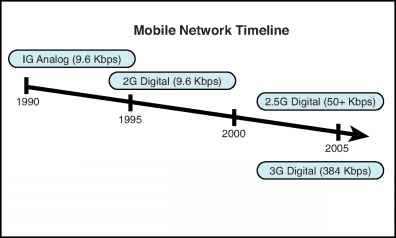The History of Mobile Network Technologies
To understand and anticipate the future, it is important to understand the past. A very strong correlation exists between the history of traditional Internet marketing and the history of mobile marketing. At first, mobile devices were used purely as a utility, much like the Internet. Not until the technology had thoroughly penetrated the mainstream market did marketers understood the power of the medium.
Mobile marketing can cover a variety of different initiatives, but it began with text and picture message marketing, the creation of mobile-friendly websites, and mobile banner advertising. Now marketers can place advertising within mobile games and mobile videos, and even within a mobile TV broadcast. More creative mobile marketers are also using full-screen interstices, which appear while a requested webpage is loading, in addition to location-based Bluetooth marketing and interactive mobile games and applications to entice their audiences.
Before you can understand the nuances of those types of marketing initiatives, you must understand the evolution of the mobile networks, handsets, operating systems, and mobile browsers. This chapter explains how those technologies have evolved and discusses how all the innovations come together to affect your marketing message.
Mobile phones are only as powerful as the network technology that runs them. A network's speed can have a huge impact on what types of mobile marketing will be successful with your demographic. Understanding how the different network technologies interact will help you make critical decisions about your mobile marketing campaign. Figure 2.1 shows the 15-year evolution of mobile networks. The following sections briefly explain each of the major mobile network technologies.
The first generation of cellphone signals was based on a circuit-switching domain and relied on an analog radio signal transmitted by the phone and picked up by towers. Radio towers used digital signals to connect to other radio towers and then to the rest of the telephone network. Because G1 technology relied on analog instead of digital signals, they were less reliant on the caller's proximity to a cellphone tower.

- Figure 2.1 Mobile networks have grown from 1G speeds of just 9.6 Kbps to 3G speeds of 384 Kbps in just 15 years, with 4G networks in the near future.
2G networks are the second generation of cellphone networks that relied on a digital signal instead of a radio signal. This technology, launched in Finland in 1991, is based primarily on a packet-switching protocol for transferring voice digitally. Phones that ran on a 2G network were smaller and had better battery life because they were not required to emit as strong of a radio signal. The voice quality on 2G phone networks was generally better and more secure because of digital encryption. Because 2G technology relied on a digital signal instead of analog signal, it was able to transmit more than voice, such as text messages and email.
2G technology was good for the carriers because it was more efficient on the spectrum. It allowed carriers to push a higher volume of calls through their network, but it relied more on proximity to a cellphone tower; when a caller moved out of range, calls were dropped entirely instead of progressively degrading. Technologies that are directly related to 2G are code division multiple access (CDMA), time division multiplex access (TDMA), and Global System for Mobile Communications (GSM).
CDMA
Used in North and South America as well as Asia, this subset of 2G technology still accounts for 17% of subscribers in the world. In code division multiple access (CDMA), the system relies on each phone being assigned a specific code, which allows multiple users to be put on the same transmission channel.
TDMA
Most 2G networks relied on time division multiplex access (TDMA) to transmit digital signals that were divided into different time slots instead of codes, as in CDMA. The signals are sent in rapid succession, all while sharing one digital channel. The timing requirements for this type of technology frequently made it unreliable as a mobile phone transmission technology because when callers moved closer to or farther away from a tower, they would misalign the timing requirements of the system and disrupt the transmission.
Global System for Mobile Communications (GSM) was developed to address some of the shortfalls of TDMA technology. It was originally created in Finland in 1991 and is now used around the world. It requires timing advance commands to be sent to the base station, which sends signals to the mobile phone, telling it whether it should transmit the signal earlier and, if so, by how much. It accounts for 80% of the subscribers around the world. GSM is the most ubiquitous set of standards for mobile phones. Because of its success, many other 2G technologies, including CDMA and TDMA, eventually transferred to GSM. GSM is so widespread that international roaming is now much more simple, because phones can almost always access a signal that they can use.
2.5G
2.5G networks offer some improvements over 2G networks but are not quite as fast as 3G networks. They use a circuit-switching domain for voice communication and a packet-switching domain for data communication. This set of standards enables high-speed data transfer over existing 2G GSM or CDMA networks that have been upgraded, and it usually describes when a 2G network has been upgraded with GPRS for data transmission. Technologies that are directly related to 2.5G are GPRS, EDGE, and iDEN.
GPRS
The first improvement in mobile data transmission, Generated Packet Radio Service (GPRS), can be added to 2G, GSM, or 3G networks. GPRS achieves moderate improvements in data transmission by using TDMA to improve packet switching over the mobile network. As with many other technologies, after its initial deployment, GPRS technology was later integrated into GSM.
EDGE
Enhanced Data Rates for GSM Evolution (EDGE) was launched in the United States by Cingular in 2003. Through optimization of packet switching, it provides better than a threefold improvement over other networks in capacity and performance of data transmission, making mobile computing and data transmission much more valuable. Sometimes referred to as 2.75G, EDGE improved the rate of data transmission over GSM networks. Although it was originally intended for GSM, it can be added to 2G, 2.5G, and GPRS networks as well.
iDEN
Integrated Digital Enhanced Network (iDEN) combined voice compression with TDMA to improve on 1G radio telephony. It is a proprietary subset of 2G technology developed by Motorola and used by Nextel in the United States and Telus in Canada. The technology is important for Nokia and Telus because it allows for push-to-talk radio and dispatch functionality that enables mobile phones to be used as long-range walkie-talkies. Many airports also use iDEN networks to enable their push-to-talk handsets.
The third full generation of mobile technology, 3G networks can provide more advanced services while achieving higher network capacity than 2G technology. In terms of data, they provide mobile phones with broadband- or near-broadband-speed transmission. These networks are functionally similar to WiFi but are meant to cover a much larger area. The first 3G network was launched in Japan by DoCOMo; later the next year, SKTelecom launched another in South Korea. Monet Mobile Networks and Verizon were the first to launch 3G technology in the United States in 2003, and the 3 Network was the first to launch in Europe (the United Kingdom and Italy). (Download: 5.8Mbps, upload: 14.4Mbps).
4G systems represent a collection of wireless standards that are all adapted to be 100% packet and IP based. They will be a complete replacement for current networks and will provide a comprehensive and secure IP solution where voice, data, and streamed multimedia can be given to users on an "anytime, anywhere" basis. 4G networks are designed to give subscribers access to much richer content on their phones, including IPTV, streaming audio and video, digital video broadcast, and video chat, at much higher data rates than previous generations. 4G promises higher network capacity and more simultaneous users per cell. (Download and upload: 15-30Mbps) Technologies directly related to 4G are WiMax, LTE, and Clearwire.
WiMax
WiMax is an IP network designed to move data instead of voice communication. It could replace mobile technologies such as GSM and CDMA or simply can be added to networks with GSM and DSMA to increase their capacity. The WiMAX Forum was formed in June 2001 to promote conformity and interoperability of the standard, called WiMAX. The group describes WiMAX as "a standards-based technology enabling the delivery of last mile wireless broadband access as an alternative to cable and DSL."
Questions still surround the viability of WiMax technology. Sprint and Clearwire are the only large service providers that have committed to using WiMax for mobile technology. Most other service providers that have embraced WiMax are using it as a fixed wireless technology. The WiMax forum anticipates that the WiMax mobile networks will focus less on service to mobile phones and more on service to other wireless Web-enabled devices.
Long-Term Evolution (LTE) it is an IP data network that optimizes the transmission of data (rather than voice) packets. It is expected to be deployed in 2010, but it competes with WiMax as the 4G standard of choice for network operators. AT&T and Verizon Wireless in the United States and many European carriers have already said they plan to use LTE instead of WiMax because it appears to be more efficient. LTE promises to bring high-speed data access not only to mobile phones, but also to HD TVs, LTE-enabled music players, and much more. Some people believe that WiMax technology will be subsumed into LTE, but that debate is still being played out.
Clearwire
Clearwire is a brand-name wireless Internet service provider (ISP) that operates in the United States, Ireland, Belgium, Spain, Denmark, and Mexico. It provides a unique wireless network that uses WiMax technology with 3G technology to provide 4G wireless network access. Clearwire launched in the United States in 2008, but its goal is to provide nationwide 4G network connections in the future. The company has been testing many different high-speed mobile technologies but has been criticized because it has not adopted the WiMax technology.
WLAN and WiFi
Wireless local area network (WLAN) technology is Internet access that is broadcast from wireless access points, otherwise known as wireless routers or "hotspots." These wireless access points send short-range radio signals that can be accessed by a variety of different devices, such as PCs, game consoles, mobile phones, MP3 players, and PDAs. Many people use the terms WLAN and WiFi interchangeable, but WiFi is actually a designation to indicate a specific WLAN technology that has been certified by the WiFi Alliance.
Bluetooth
Developed in 1994 but popularized in the late 1990s, Bluetooth technology uses radio broadcast to allow multiple proximal devices to recognize each other and send information between them wirelessly. When multiple Bluetooth devices are linked in a group, it is called a personal area network (PAN). Bluetooth can connect many devices, including mobile phones, computers, printers, digital cameras, and video game consoles, and allow them to pass information back and forth.
VoIP
VoIP stands for voice over Internet Protocol or voice over IP. It is simply a means of using a broadband Internet signal to transmit voice. Skype and Vonage were the first to make this type of communication mainstream. With the addition of a signal converter or a headset on the computer, VoIP calling allows computers to have phone calls with other computers or directly with phones. Because this can be done at a very low cost, many traditional phone service carriers are losing customers to VoIP services. As mobile data networks improve, mobile VoIP is becoming a reality that many mobile careers are reticent to embrace.
FemtoCell
FemtoCell is a technology that is used indoors to boost indoor mobile handset signals by converting a wired broadband signal into a radio signal that mobile phones can pick up. AT&T, Sprint, and Verizon already offer FemtoCell base stations for subscribers' homes, and it is also being deployed in some commercial locations. This type of technology will likely be important for improving access to mobile marketing messages to your demographic when they are inside and mobile signals are weaker.
Similar to FemtoCell, UMA is deployed through a base station that uses WiFi signals to carry voice and data from mobile handsets to a base station. The base station provides improved access to GSM and GPRS by tapping into unlicensed aspects of the network spectrum. In the United States, this is being promoted by T-Mobile; in the United Kingdom, it is being promoted by British Telecom.
Continue reading here: The History of Mobile Browsers
Was this article helpful?

